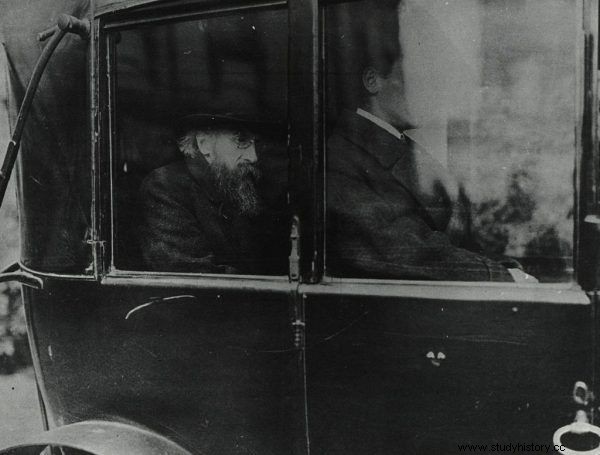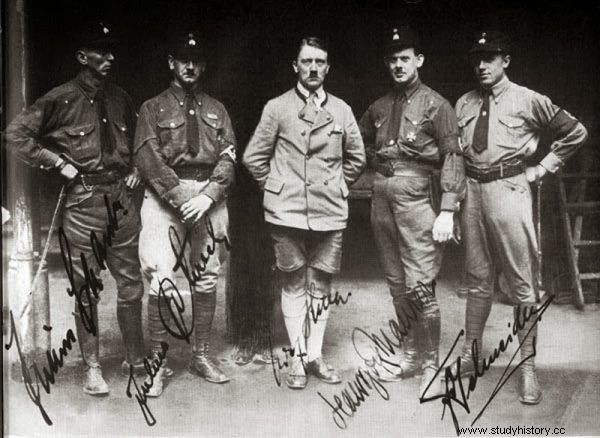Creator of Nazism, or anti-communist, anti-democratic and anti-Semitic ideology mourning a leftist pacifist of Jewish origin? Plus those serving under the banner of the Bolshevik Soviet Republic? Hitler tried to hide these pages of his biography at all costs.
On February 26, 1919, the solemn funeral of Kurt Eisner, murdered a few days earlier by an extreme nationalist, was held in Munich. Eisner, a well-known journalist, politician, and pacifist of Jewish origin, was the leader of the Bavarian November Revolution, which led to the creation of a socialist state entity, the Free State of Bavaria. In it, the dead man held the office of prime minister.
The funeral attracted crowds of Munich people, as evidenced by fragments of a completely unique film, shot during the funeral parade. A trained eye will notice a familiar-looking figure among the marchers. Characteristic mustache, hairstyle, posture ... Wait a minute, could it be him?
Not the left wing, not the right wing, but just a communist?
Hitler, as the embodiment of evil, is used in political verbal fencing to this day. His name and the ideology he created are used as the heaviest offense against the opponent. The chaotic set of political doctrines of this criminal is difficult to put into a political framework. That is why contemporary politicians and publicists, according to their beliefs, throw him once in a right-wing, sometimes a left-wing bag.
However, the presence of Hitler at the funeral of Eisner - a leftist pacifist of Jewish origin - may be astonishing. Has (as some interpreters of this film would like) the young, thirty-year-old Hitler also found himself flirting with communism and the Bolsheviks?

Kurt Eisner three months before his death.
Adolf after the defeat of the war
The end of World War I, combined with the surrender of Germany, was a huge blow to the young Adolf Hitler. Peter Longerich, the author of his new biography entitled "Hitler" , describes this moment on the basis of Hitler's memories. :
(…) W fell into the deepest despair, cried for the first time since his mother's death and felt deep embarrassment, which made itself felt directly by somatic symptoms . "With the darkness in my eyes again, I stumbled back into the bedroom, threw myself on the bed and hid my burning head under the blanket and pillows." The more he tried to "embrace this unheard-of event, the more the shame of indignation and disgrace burned my forehead."
Hitler, unlike his peers, had nowhere to return to. Apart from the army, nothing was waiting for him - neither a greeting from happy parents, nor meetings with friends or colleagues. Hitler had no one. So general demobilization was the worst that could have happened to him then.

In Red Bavaria
Meanwhile, the collapsing German Empire was plunging into chaos. Interestingly, it also boiled over a conservative, less proletarian, and definitely more agricultural, Bavaria. Undoubtedly influenced by the Bolshevik October Revolution, the crowds raised power straight from the streets. The real leader of the changes was the aforementioned Kurt Eisner, leader of the Independent Socialist Party of Germany. He made a virtually bloodless seizure of power, creating the Free State of Bavaria. To quote Longerisch's position "Hitler" :
The war fatigue of a large part of the population and widespread dissatisfaction with the monarchist regime led to a major political shift:on the very next day, November 8, government power was taken over by the "National Council" (Nationalrat) composed of representatives of peasants' and soldiers' councils, the faction of the SPD and the Bavarian Peasants' Union (Bayerischer Bauernbund) in the Landtag and three liberal MPs, appointing Eisner as his prime minister. Soldiers' councils were set up in the barracks, with a moderate tendency towards the Majority Social Democracy (Mehrheitssozialdemokratie) in the 2nd Infantry Regiment.
Where was Hitler at that time? What was he doing then?

Adolf Hitler in Bavarian clothes in the photo from 1925.
An activist in the leftist army
Hitler, after the surrender of Germany, continued to cling to the army. It is known that in December he was sent to a guard detachment whose task was to guard prisoners of war. The stay in the Traunstein camp did not last long, however. A month later, he returned to Munich, already ruled by socialists, Eisner, and landed in the demobilization battalion of his regiment. The specter of the end of his adventure with the uniform kept staring in his eyes - but once again he managed to escape demobilization.
The future criminal was chosen as the "man of trust" of his company. It was a function that combined many tasks:he recruited soldiers to work in agriculture, but was also supposed to act as an agitator and influence their worldview. In the latest book by Longerich "Hitler. Biography ” we also find the following information:
There is no doubt, however, that the military stationed in Munich was then heavily influenced by the revolutionary left. For example, on Sunday, February 16, those soldiers of the demobilization battalion who were free at the time, at the behest of the battalion command, took part - along with the entire Munich garrison - in a demonstration by the Revolutionärer Arbeiterrat, demanding the proclamation of a Soviet republic.

Revolutionary soldiers on a patrol in the streets of Munich in 1919.
It cannot therefore be ruled out that Adolf Hitler himself was among the protesting soldiers. Moreover, due to his function, should even be assumed to be present at the left-wing rally !
At the service of the revolution
There are many indications that the mustachioed man parading during the solemn funeral of the pacifist and socialist Eisner may have been Hitler. In addition to the physical similarity, this is also evidenced by the document which confirms that 25 soldiers and 6 representatives of the barracks council were delegated from the battalion in which he served.
It's not everything. It is known that Hitler remained in office also after the establishment, shortly after Eisner's death, of the thoroughly revolutionary Bavarian Soviet Republic. Another upheaval was a stronger shift of the lever to the left. New elections of military agitators were held and Hitler, once again, passed the verification positively .

On April 15, he was re-elected by the Second Company to the battalion council in the backup battalion ( Ersatz-Bataillonsrat ). It is certain, then, that when he was in his military service, he also served the Bavarian authorities. The one who carried revolutionary and Bolshevik slogans on their banners. For this reason, can we say unequivocally that 30-year-old Adolf Hitler was kidnapped by communist ideology?
Power changes, he always on committees
In the book "Mein Kampf", containing autobiographical elements, Adolf Hitler devoted little space to the events of the end of 1918 and the first half of 1919. The author focused on the description of the trauma related to the defeat of Germany and the search for those responsible for this situation (it is known that the Jews are responsible for everything!).
So it seems that he was not very happy with his activities during this period and made efforts to cover up this biographical thread as much as possible. Still, associating it with the communist movement is, however, a tremendous abuse. We already know that he performed military service during the rule of the Bavarian Soviet Republic. But he showed relative loyalty - and nothing more.

The first German edition of "Mein Kampf" - a book in which very little space is devoted to the events of the turn of 1918-1919.
However, neither from this circumstance, nor from other references to Hitler's activities at that time, it is impossible to conclude that in the first months of 1919 he was a supporter of the Soviet movement. - writes in the book "Hitler" Peter Longerich - In this position, he was obliged to fulfill the orders of the soldier's council and in certain situations to represent his company, but we do not know what his political attitude was.
Most likely then, like many of his companions with a similar worldview, he assumed a wait-and-see position. There is also one fact that he did not sell himself to the communists. After the overthrow of the Bavarian Soviet Republic and the seizure of power by the local right, Hitler continued to hold important military functions. Moreover, he was the one who verified the soldiers in terms of their behavior during the communist regime!
The guy who loved the uniform
Thirty-year-old Hitler was a walking set of radical views. The most expressive was the belief in the superiority of the German nation over all the others, hatred of Jews, dislike of the Slavs, capitalists and the Catholic Church (as well as dozens of other social and philosophical groups).

Hitler in 1923, while driving a car. At that time, he was already expressing his aversion to communism.
Some researchers believe that his aversion to communism resulted not from ideological but national reasons. Hitler probably thought, drawing on experience from the times of the Bavarian Soviet Republic, that the communist movement was entirely dominated by Jews.
Hitler fought Bolshevism not because he was an anti-socialist, but because he considered it a "Jewish creation" - we read in the study "Europa. Historical regions and states ”edited by Marcin Kamler. One English scholar, George Watson, once aptly described National Socialism as "non-theoretical Marxism."
The direct association of Hitler with the communist movement, based on activities during the short existence of the Bavarian Soviet Republic, seems to be an overinterpretation, however. Hitler remained in the army because he felt comfortable in it. By abandoning the uniform, he would again become an ordinary, insignificant man who completely does not know what to do with himself .
Buy Hitler's biography cheaper on Empik.com:

